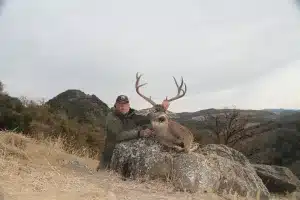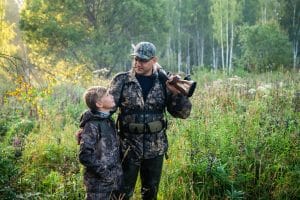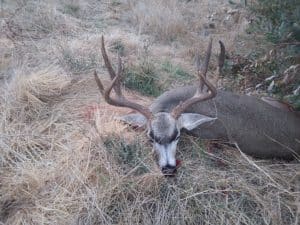California’s black-tailed deer season offers some of the most rewarding hunting experiences on the West Coast. These elusive deer roam the state’s diverse terrain, from coastal redwood forests to oak-studded foothills, presenting unique challenges that separate novice hunters from seasoned pros.
Are you prepared to make this season your most successful yet? This comprehensive guide covers everything you need to know about California black-tailed deer hunting, from understanding their behavior patterns to securing the right gear and finding prime hunting locations. Whether you’re a first-time hunter or looking to improve your success rate, these proven strategies will help you maximize your opportunities this season.
Understanding Black-Tailed Deer Behavior 
Black-tailed deer are masters of adaptation, thriving in California’s varied ecosystems. These deer differ significantly from their white-tailed cousins, displaying unique behavioral patterns that smart hunters learn to exploit.
Feeding Patterns and Timing
Black-tailed deer are crepuscular, meaning they’re most active during dawn and dusk. They feed heavily on browse plants, acorns, and seasonal vegetation. During summer months, they focus on green forbs and leaves, while fall brings a shift to acorns and woody browse.
Early morning hunting proves most effective, with deer moving from bedding areas to feeding zones. Evening hunts can be productive, but deer often feed closer to their daytime bedding areas, making them harder to approach.
Seasonal Movement Patterns
California’s black-tailed deer exhibit altitudinal migration patterns. Summer finds them at higher elevations seeking cooler temperatures and abundant food sources. As temperatures drop and hunting pressure increases, they move to lower elevations with thicker cover.
Understanding these migration routes gives hunters a significant advantage. Identifying transition zones between feeding and bedding areas increases your chances of intercepting deer during their daily movements.
Habitat Preferences
Black-tailed deer prefer edge habitats where forests meet meadows or clearings. They seek areas with:
- Dense cover for bedding security
- Nearby water sources
- Diverse food options
- Escape routes to thick timber
Coastal regions offer an ideal habitat with mild temperatures and year-round vegetation. Inland areas provide excellent hunting opportunities, especially in oak woodlands and mixed conifer forests.
Essential Gear Checklist 
Success depends heavily on having the right equipment. Your gear selection can make the difference between a successful hunt and going home empty-handed.
Firearms and Ammunition
Choose a rifle capable of accurate shots at varying distances. Popular calibers for black-tailed deer include:
- .243 Winchester (excellent for smaller deer)
- .270 Winchester (versatile all-around choice)
- .30-06 Springfield (proven performer)
- 7mm-08 Remington (low recoil, high performance)
Select premium ammunition designed for medium-sized game. Controlled expansion bullets provide excellent terminal performance on black-tailed deer.
Optics and Rangefinding
Quality optics are non-negotiable for successful hunting. Invest in:
- Binoculars (8×42 or 10×42 for versatility)
- Rifle scope (3-9×40 or variable power)
- Rangefinder (essential for accurate shot placement)
California’s diverse terrain demands optics that perform in various lighting conditions. Anti-reflective coatings and quality glass make spotting deer in dense cover much easier.
Clothing and Camouflage
Layer your clothing system for California’s variable weather conditions. Essential items include:
- Moisture-wicking base layers
- Insulating mid-layers
- Waterproof outer shell
- Quality hunting boots
- Camouflage pattern suited to your hunting area
Choose camouflage that matches your specific hunting zone. Coastal areas require different patterns than inland oak woodlands.
Additional Equipment
Don’t forget these crucial items:
- Sharp field dressing knife
- Game bags and a cooler
- Headlamp with extra batteries
- First aid kit
- GPS device or a smartphone with offline maps
- Hunting license and deer tags
Top Hunting Locations in California 
California offers diverse hunting opportunities across different zones. Each area presents unique challenges and requires specific strategies.
Northern California Zones
Zone A encompasses coastal regions with excellent black-tailed deer populations. The combination of mild climate and abundant food sources creates ideal conditions. Mendocino National Forest and the surrounding areas offer public land opportunities.
Zone B covers inland areas with oak woodlands and grasslands. These zones typically open earlier and provide excellent archery opportunities. Success rates often exceed coastal areas due to more predictable deer movements.
Central California Opportunities
Zones D4 and D5 provide some of the state’s best black-tailed deer hunting. These areas feature diverse habitat types and healthy deer populations. Public land access exists, but private ranch hunts often yield better results.
The Los Padres National Forest offers extensive public hunting opportunities. Research specific units and access points before your hunt to maximize your time afield.
Southern California Options
Zone D16 and the surrounding areas provide hunting opportunities closer to major population centers. These zones face higher hunting pressure but still maintain viable deer populations.
Focus on remote areas requiring longer hikes to escape hunting pressure. Your effort will be rewarded with better deer encounters and improved success rates.
Tips for Successful Hunting
Mastering specific techniques dramatically improves your hunting success. These proven strategies help you connect with California’s black-tailed deer.
Scouting and Preparation
Pre-season scouting is crucial for success. Look for:
- Fresh tracks and droppings
- Well-used trails and bedding areas
- Food sources (acorns, browse plants)
- Water sources
- Rubs and scrapes during the rutting season
Use trail cameras to pattern deer movements and identify shooter bucks. This information becomes invaluable when planning your hunting strategy.
Hunting Strategies
Still-hunting proves effective in California’s varied terrain. Move slowly through deer habitat, pausing frequently to glass ahead. This method works particularly well in oak woodlands and mixed forests.
Standing hunting near water sources, feeding areas, or travel corridors can be productive. Position yourself downwind from expected deer movement patterns.
Spot-and-stalk hunting excels in open country where you can glass large areas. Use terrain features to plan your approach and get within shooting range.
Shot Placement and Recovery
Proper shot placement ensures clean, ethical kills. Aim for the heart-lung area just behind the front shoulder. Avoid shots at running deer or through heavy brush.
After the shot, mark the location and wait before trailing. Black-tailed deer often bed down if not pursued immediately. Follow blood trails carefully and use proper field dressing techniques.
Safety Guidelines
Hunting safety must be your top priority. California’s diverse terrain and hunting conditions require extra attention to safety protocols.
Firearm Safety
Always treat your firearm as loaded. Never point the muzzle at anything you don’t intend to destroy. Know your target and what lies beyond it before shooting.
Hunter orange requirements vary by zone and season. Check current regulations and wear appropriate safety colors when required.
Environmental Hazards
California’s hunting areas present various environmental challenges:
- Steep terrain and loose rock
- Poisonous plants (poison oak)
- Extreme weather conditions
- Venomous snakes and insects
Inform someone of your hunting plans and expected return time. Carry emergency communication devices in remote areas.
Wildlife Encounters
Black bears and mountain lions often inhabit areas where deer hunting is prevalent. Store food properly and make noise while moving through thick cover. Carry bear spray in areas with high bear activity.
Regulations and Licensing
Understanding California’s hunting regulations ensures legal compliance and protects the resource for future generations.
Licensing Requirements
All hunters must possess:
- Valid California hunting license
- Deer tag for a specific zone
- Hunter education certification
- Federal duck stamp (if hunting waterfowl)
Purchase licenses and tags through the California Department of Fish and Wildlife website or authorized dealers.
Season Dates and Bag Limits
Season dates vary by zone and type of weapon. The general season typically runs from late July through December, with specific dates varying by location.
Bag limits are usually one deer per tag, with antler restrictions in some zones. Some areas offer additional deer tags through lottery systems.
Special Regulations
Many zones have specific regulations regarding:
- Weapon types allowed
- Hunting hours
- Private land access
- Check-in requirements
Study the current hunting regulations booklet carefully before your hunt. Regulations change annually, and violations carry serious penalties.
Ready to Experience California’s Best Black-Tailed Deer Hunting?
California’s black-tailed deer season offers incredible opportunities for hunters willing to put in the effort. Success comes from understanding deer behavior, using proper equipment, and applying proven hunting strategies.
The key to consistent success lies in thorough preparation and choosing the right hunting location. Whether you prefer the coastal forests or inland oak woodlands, California’s diverse terrain provides options for every hunting style.
Don’t let another season pass without experiencing the thrill of pursuing these magnificent animals. California’s black-tailed deer populations are healthy, and hunting opportunities abound for those ready to take advantage.
Book your hunting trip now and discover why California’s black-tailed deer hunting ranks among the West Coast’s premier hunting experiences. Your most successful season awaits!
